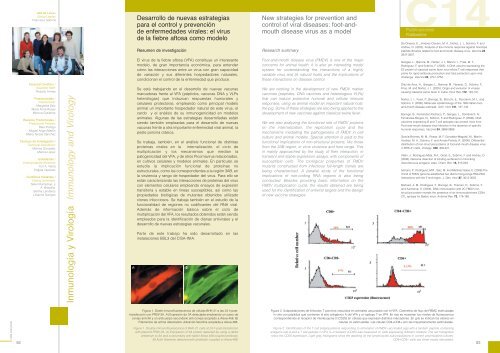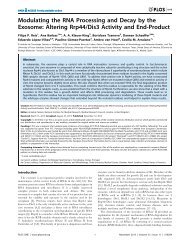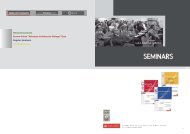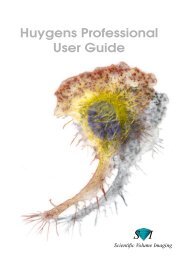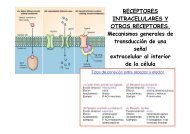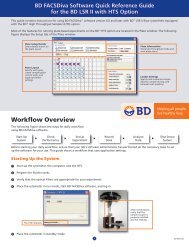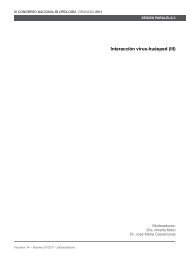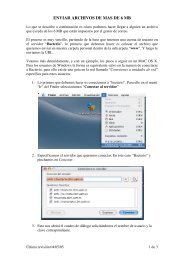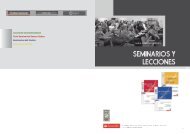Drosophila - Severo Ochoa - Universidad Autónoma de Madrid
Drosophila - Severo Ochoa - Universidad Autónoma de Madrid
Drosophila - Severo Ochoa - Universidad Autónoma de Madrid
Create successful ePaper yourself
Turn your PDF publications into a flip-book with our unique Google optimized e-Paper software.
Jefe <strong>de</strong> Línea /<br />
Group Lea<strong>de</strong>r:<br />
Francisco Sobrino<br />
Personal Científico /<br />
Scientific Staff:<br />
Rosario Armas<br />
Postdoctorales /<br />
Postdoctoral:<br />
Margarita Sáiz<br />
María Flora Rosas<br />
Mónica Gutiérrez<br />
Becarios Predoctorales /<br />
Predoctoral Fellows:<br />
Raúl Postigo<br />
Miguel Angel Martín<br />
María Teresa Sánchez<br />
Técnicos <strong>de</strong> Investigación /<br />
Technical Assistance:<br />
Mónica González<br />
Marina López<br />
Estudiantes /<br />
Un<strong>de</strong>rgraduate Stu<strong>de</strong>nts:<br />
Yuri A. Vieira<br />
Ángela Vázquez<br />
Científicos Visitantes /<br />
Visiting Scientists:<br />
Søren Kamstrup, ç<br />
A. Braedfor<br />
Bertha Lan<strong>de</strong>ros<br />
Llilianne Ganges<br />
Inmunología y Virología Immunology and Virology<br />
Desarrollo <strong>de</strong> nuevas estrategias<br />
para el control y prevención<br />
<strong>de</strong> enfermeda<strong>de</strong>s virales: el virus<br />
<strong>de</strong> la fiebre aftosa como mo<strong>de</strong>lo<br />
Resumen <strong>de</strong> investigación<br />
El virus <strong>de</strong> la fiebre aftosa (VFA) constituye un interesante<br />
mo<strong>de</strong>lo, <strong>de</strong> gran importancia económica, para enten<strong>de</strong>r<br />
cómo las interacciones entre un virus con gran capacidad<br />
<strong>de</strong> variación y sus diferentes hospedadores naturales,<br />
condicionan el control <strong>de</strong> la enfermedad que produce.<br />
Se está trabajando en el <strong>de</strong>sarrollo <strong>de</strong> nuevas vacunas<br />
marcadoras frente al VFA (péptidos, vacunas DNA y VLPs<br />
heterólogas) que induzcan respuestas humorales y<br />
celulares protectoras, empleando como principal mo<strong>de</strong>lo<br />
animal un importante hospedador natural <strong>de</strong> este virus, el<br />
cerdo y el análisis <strong>de</strong> su inmunogenicidad en mo<strong>de</strong>los<br />
animales. Algunas <strong>de</strong> las estrategias <strong>de</strong>sarrolladas están<br />
siendo también empleadas para el <strong>de</strong>sarrollo <strong>de</strong> nuevas<br />
vacunas frente a otra importante enfermedad viral animal, la<br />
peste porcina clásica.<br />
Se trabaja, también, en el análisis funcional <strong>de</strong> distintas<br />
proteínas virales en la internalización, el ciclo <strong>de</strong><br />
multiplicación y los mecanismos que median la<br />
patogenicidad <strong>de</strong>l VFA, y <strong>de</strong> otros Picornavirus relacionados,<br />
en cultivos celulares y mo<strong>de</strong>los animales. En particular, se<br />
estudia la implicación funcional <strong>de</strong> proteínas no<br />
estructurales, como las correspondientes a la región 3AB, en<br />
la virulencia y rango <strong>de</strong> hospedador <strong>de</strong>l virus. Para ello se<br />
están caracterizando las interacciones <strong>de</strong> proteínas <strong>de</strong>l virus<br />
con elementos celulares empleando ensayos <strong>de</strong> expresión<br />
transitoria y estable en líneas susceptibles, así como las<br />
propieda<strong>de</strong>s biológicas <strong>de</strong> mutantes obtenidos utilizado<br />
clones infecciosos. Se trabaja también en el estudio <strong>de</strong> la<br />
funcionalidad <strong>de</strong> regiones no codificantes <strong>de</strong>l RNA viral.<br />
A<strong>de</strong>más <strong>de</strong> información básica sobre el ciclo <strong>de</strong><br />
multiplicación <strong>de</strong>l VFA, los resultados obtenidos están siendo<br />
empleados para la i<strong>de</strong>ntificación <strong>de</strong> dianas antivirales y el<br />
<strong>de</strong>sarrollo <strong>de</strong> nuevas estrategias vacunales.<br />
Parte <strong>de</strong> este trabajo ha sido <strong>de</strong>sarrollado en las<br />
instalaciones BSL3 <strong>de</strong>l CISA-INIA.<br />
New strategies for prevention and<br />
control of viral diseases: foot-andmouth<br />
disease virus as a mo<strong>de</strong>l<br />
Research summary<br />
Foot-and-mouth disease virus (FMDV) is one of the major<br />
concerns for animal health. It is also an interesting mo<strong>de</strong>l<br />
system for un<strong>de</strong>rstanding the interactions of a highly<br />
variable virus and its natural hosts and the implications of<br />
these interactions on disease control.<br />
We are working in the <strong>de</strong>velopment of new FMDV marker<br />
vaccines (pepti<strong>de</strong>s, DNA vaccines and heterologous VLPs)<br />
that can induce protective humoral and cellular immune<br />
responses, using as animal mo<strong>de</strong>l an important natural host:<br />
the pig. Some of these strategies are also being applied to the<br />
<strong>de</strong>velopment of new vaccines against classical swine fever.<br />
We are also analyzing the functional role of FMDV proteins<br />
on the internalization, the replication cycle and the<br />
mechanisms mediating the pathogenesis of FMDV in cell<br />
culture and animal mo<strong>de</strong>ls. Special attention is paid to the<br />
functional implications of non-structural proteins, like those<br />
from the 3AB region, in virus virulence and host range. This<br />
in mainly approached by the study of their interaction, in<br />
transient and stable expression assays, with components of<br />
susceptible cells. The biological properties of FMDV<br />
mutants constructed from infectious full-length clones are<br />
being characterized. A parallel study of the functional<br />
implications of non-coding RNA regions is also being<br />
conducted. Besi<strong>de</strong>s providing basic information on the<br />
FMDV multiplication cycle, the results obtained are being<br />
used for the i<strong>de</strong>ntification of antiviral targets and the <strong>de</strong>sign<br />
of new vaccine strategies<br />
C14<br />
Publicaciones<br />
Publications<br />
De Oliveira, E., Jiménez-Clavero, M. A., Núñez, J. I., Sobrino, F. and<br />
Andreu, D. (2005). Analysis of the immune response against mixotope<br />
pepti<strong>de</strong> libraries related to foot-and-mouth disease virus. Vaccine 23,<br />
2647-2657.<br />
Ganges, L., Barrera, M., Núñez, J. I., Blanco, I., Frias, M. T.,<br />
Rodríguez, F. and Sobrino, F. (2005). A DNA vaccine expressing the<br />
E2 protein of classical swine fever virus elicits T cell responses that<br />
prime for rapid antibody production and total protection upon viral<br />
challenge. Vaccine 23, 3741-3752.<br />
Díaz <strong>de</strong> Arce, H., Ganges, L., Barrera, M., Naranjo, D., Sobrino, F.,<br />
Frías, M. and Núñez, J. I. (2005). Origin and evolution of viruses<br />
causing classical swine fever in Cuba. Virus Res. 112, 123-131.<br />
Núñez, J. I., Fussi, P., Borrego, B., Brocchi, E., Pacciarini, M. L. and<br />
Sobrino, F. (2006). Molecular epi<strong>de</strong>miology of the 1993 Italian footand-mouth<br />
disease outbreak. Arch. Virol. 151, 127-142.<br />
Borrego, B., Fernán<strong>de</strong>z-Pacheco, P., Ganges, L., Doménech, N.,<br />
Fernán<strong>de</strong>z-Borges, N., Sobrino, F. and Rodríguez, F. (2006). DNA<br />
vaccines expressing B and T cell epitopes can protect mice from<br />
Foot-and-mouth disease virus infection in the absence of specific<br />
humoral responses. Vaccine 24, 3889-3899.<br />
García-Briones, M. M., Rosas, M. F, González-Magaldi, M., Martín-<br />
Acebes, M. A., Sobrino, F. and Armas-Portela, R. (2006). Differential<br />
distribution of non-structural proteins of foot-and-mouth disease virus<br />
in BHK-21 cells. Virology. 349, 409-421.<br />
Villén, J., Rodríguez-Mias, R.A., Giralt, E., Sobrino, F. and Andreu, D.<br />
(2006). Racional disection of binding surfaces for mimicking<br />
discontinuous antigenic sites. Chem. Biol. 13, 815-823.<br />
Serrano, P., Rodríguez, M.R., Saiz, M. and Martínez-Salas, E. (2006).The<br />
3´end of FMDV genome establishes two distinct long-range RNA-RNA<br />
interactions with the 5´end region. J. Gen. Virol. 87, 3013-3022.<br />
Barfoed, A. M., Rodriguez, F., Borrego, B., Therrien, D., Sobrino, F.<br />
and Kamstrup, S. (2006). DNA immunization with 2C FMDV nonstructural<br />
protein reveals the presence of an immunodominant CD8+,<br />
CTL epitope for Balb/c mice. Antiviral Res. 72, 178-189.<br />
CBM 2005/2006<br />
82<br />
Figura 1. Doble inmunofluorescencia <strong>de</strong> células BHK-21 a las 24 h posttransfección<br />
con PRSV-3A. A) Expresión <strong>de</strong> 3A <strong>de</strong>tectada empleando un suero <strong>de</strong><br />
conejo anti-3A y un anticuerpo secundario anti-conejo acoplado a Alexa-456. B)<br />
Filamentos <strong>de</strong> actina <strong>de</strong>tectados utilizando faloidina acoplada a Alexa-488.<br />
Figure 1. Double immunofluorescence of BHK-21 cells at 24 h post-transfection<br />
with plasmid PRSV-3A. A) Expression of 3A protein <strong>de</strong>tected by using a rabbit<br />
antiserum to 3A and a secondary anti-rabbit Alexa 456-coupled antibody.<br />
B) Actin filaments <strong>de</strong>tected with phalloidin coupled to Alexa-488.<br />
Figura 2. Subpoblaciones <strong>de</strong> linfocitos T porcinos inducidos en animales vacunados con el VFA. Citometría <strong>de</strong> flujo <strong>de</strong> PBMC estimuladas<br />
in vitro con péptidos que contienen el sitio antigénico A <strong>de</strong>l VFA y un epítopo T en VP4. En rojo se muestran los niveles <strong>de</strong> fluorescencia<br />
correspondientes al receptor <strong>de</strong> interleuquina-2 (CD25) en células que expresan distintos marcadores. En gris se indican los valores en<br />
células no estimuladas. Las células CD4+CD8+ son las mayoritariamente estimuladas.<br />
Figure 2. I<strong>de</strong>ntification of the T cell subpopulations responding to stimulation of FMDV vaccinated pigs with a tan<strong>de</strong>m pepti<strong>de</strong> containing<br />
antigenic site A and a T cell epitope in VP4. IL-2 receptor (CD25) was measured on cells expressing different markers. The red histograms<br />
show the CD25 expression. Light grey histograms show the labelling on the lymphocytes sub-populations in control unstimulated cultures.<br />
CD4+CD8+ cells are those mostly stimulated.<br />
83


